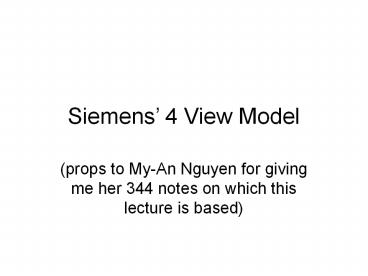Siemens PowerPoint PPT Presentation
Title: Siemens
1
Siemens 4 View Model
- (props to My-An Nguyen for giving me her 344
notes on which this lecture is based)
2
(No Transcript)
3
(No Transcript)
4
Conceptual View Activities
- Central design tasks.
- Create conceptual
- components, connectors, ports, roles, protocols.
- configuration.
- Global evaluation.
- Final design task.
- Software resource budgeting (memory, CPU time,
).
5
What is a Module Definition
- Think of it as a UML package.
- Does not imply that code will be
non-Object-Oriented. - In execution view, will eventually hold either
Object-Oriented (classes, ) or
non-Object-Oriented code.
6
Module View Activities
- Central design tasks.
- Definition of subsystems, layers, modules.
- Allocation of conceptual elements to the above.
- Global evaluation.
- Final design task.
- Design of (key) module interfaces
- Operations (name, signature
7
(No Transcript)
8
Execution View Definition
- Define / perform
- Mapping of conceptual components and modules to
run-time entities. - Run-time entities e.g. tasks, processes,
threads. - o Communication paths mechanisms.
- o Configuration.
- o Resource allocation.
- We are concerned with non-trivial views
- Trivial Execution View software that uses a
single thread and process.
9
Execution View Activities
- Central design tasks.
- Define run-time entities, communication paths,
execution configuration. - (Global evaluation)
- Final design task.
- Resource allocation.
10
(No Transcript)
11
Code View Definition (1)
- Define / perform
- Mapping of modules from the Module View to source
components - Mapping of run-time entities from the Execution
View to deployment components - Define intermediate components dependencies.
- Organization of these components.
- Build and Configuration Management.
12
Code View Definition (2)
- Key words
- Source components.
- Intermediate components.
- Deployment components.
- Dependencies between components.
- We are concerned with non-trivial views
- Trivial Code View software with a single
executable and a small development team. The Code
View will then mimic the Module View.
13
Code View Activities
- Central design tasks. Define organize
- Source Components ( dependencies).
- Intermediate Components ( dependencies).
- Deployment Components ( dependencies).
- (Global evaluation)
- Final design task
- Build procedure.
- Configuration management.
14
Code View (common complaints)
- Consider what if
- Customer X has a problem with their release that
was last built in October, then patched in
December and January. You need to run tests to
confirm the problem. - The Probe S/W team has just issued a new release,
you need to integrate and test - The Code View contains architectural decisions
concerning the code!
15
IS2000 (look familiar?)
16
Case study (1)IS2000 Execution and Code View
Global Analysis
- The few strategies applicable to the Execution
View - Issue Skill Deficiencies
- Strategy Avoid use of multiple threads.
- Strategy Encapsulate multiprocess support
facilities. - Key concern for view performance.
17
Case study (2)IS2000 Execution and Code View
Global Analysis
- Introduce new issue High Throughput
- Probe has higher data rate than previous
products. - Image processing must keep up with probe.
- Solutions/Strategies
- Map independent threads of control to processes.
However, there was only one developer with
experience in multithreading and the cost of
creating/destroying processes is low. - Use an additional CPU.
- Avoid the use of multiple threads.

